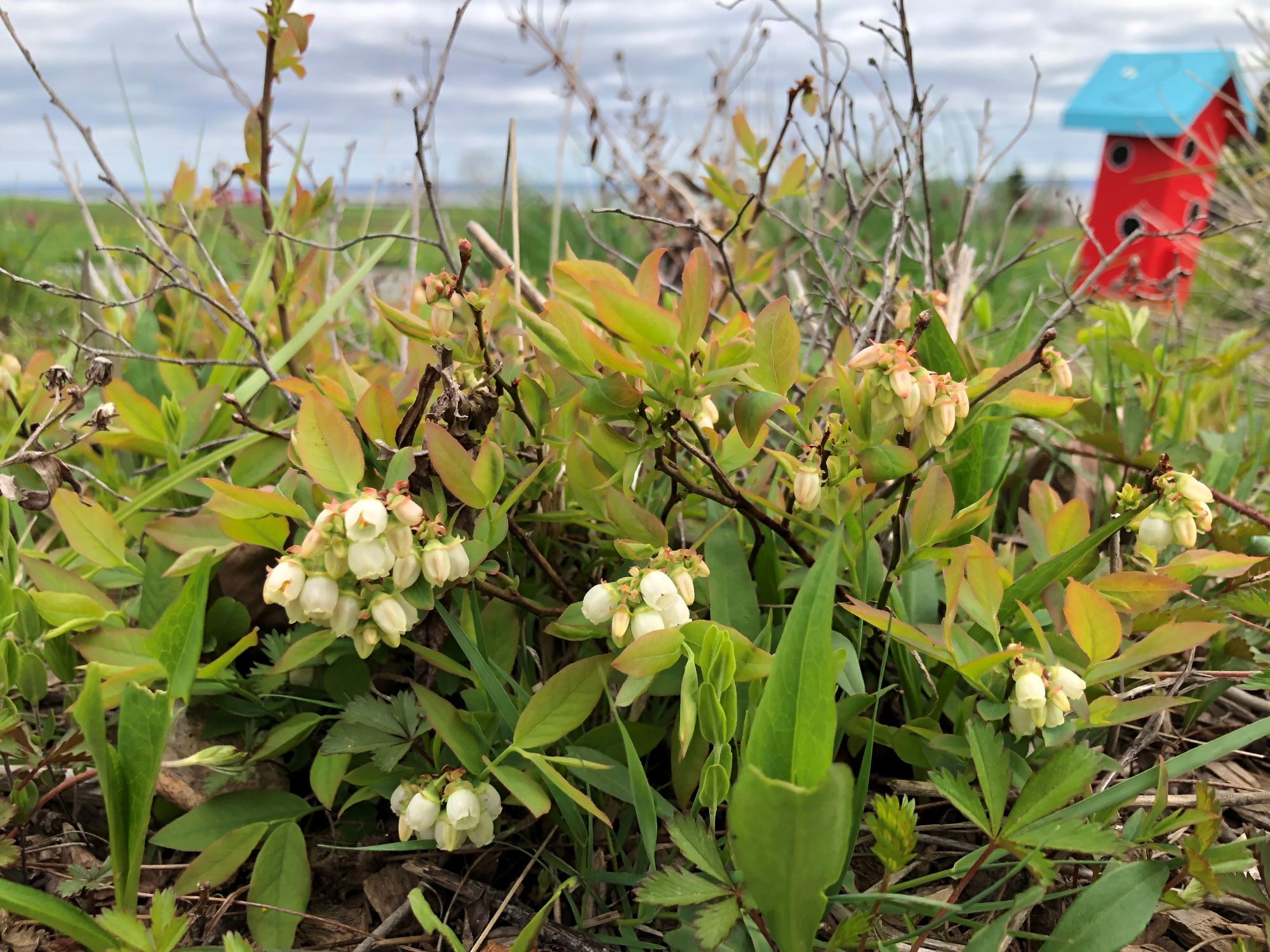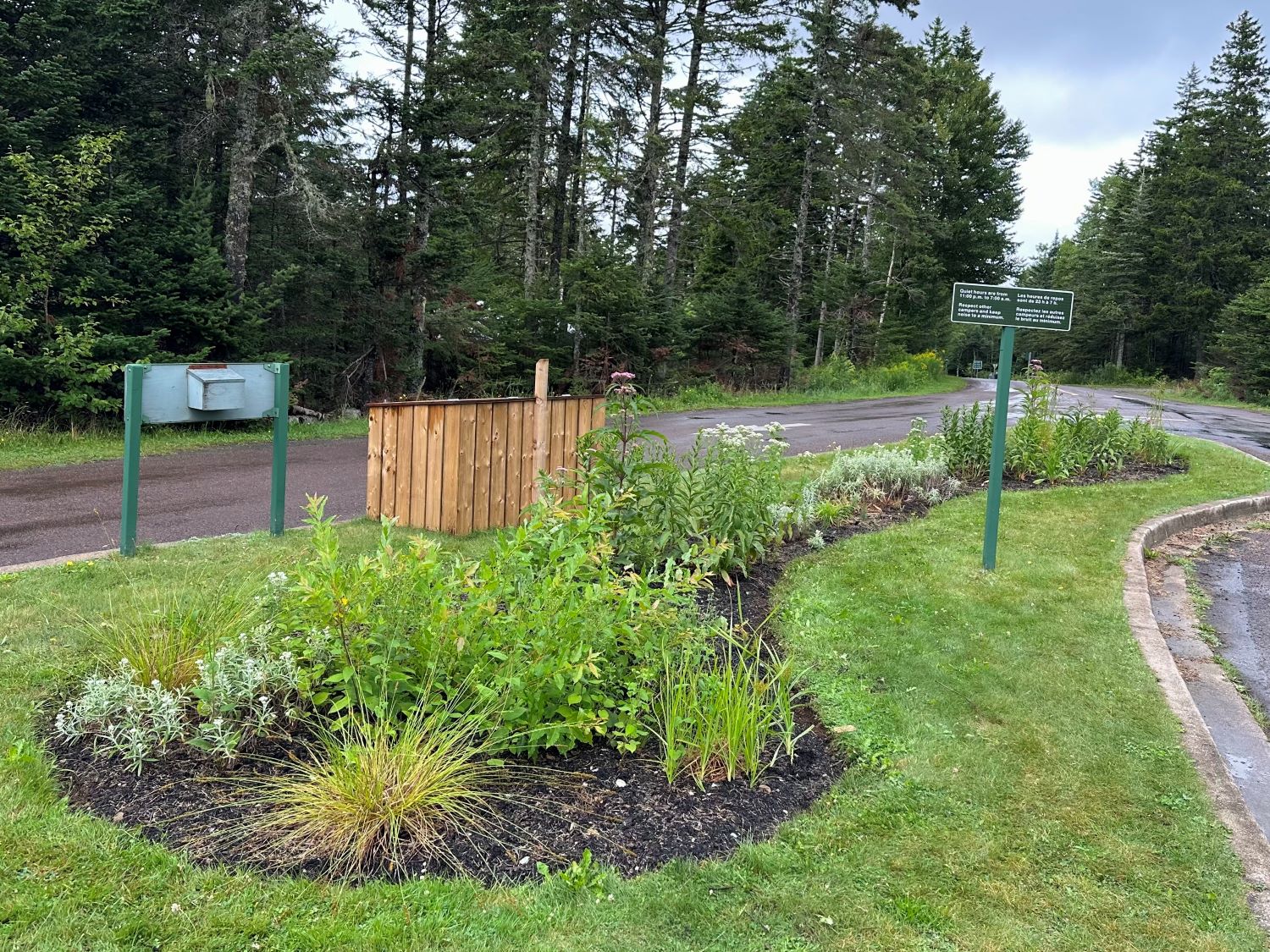Native Plants at Home
Imagine landscaping your yard as a solution to today's environmental challenges, by adding to it the beauty of nature!
Imagine landscaping your yard as a solution to today’s environmental challenges, by adding to it the beauty of nature!
Think of the time you spent playing outdoors in natural areas as a child. These spaces are becoming increasingly rare.
In North America, turf is the most widespread crop in terms of surface area. This green carpet is very useful for creating areas for relaxation and entertainment, but it is too often dominant, leading to landscapes where only a few animal species can survive.
Although turf has its place in our communities, other landscaping methods exist.
Development and nature can coexist
We are part of nature, because we depend on the relationships between animals and plants. To give back to nature what it gives us, we should add native plants to our spaces. They provide food and habitat for animals, while filtering rainwater and preventing erosion. This approach is also crucial for adapting to climate change.
That’s what this page is all about. If you want to make an impact, including these plants adapted to our region in your yard is one of the best ways to create a difference.
Table of Contents
Principles for helping wildlife with native plants
Types of landscaping using native plants
a) The pollinator garden (+ Example : Fundy national park)
b) The Forest Garden
c) Rain Gardens and Ponds
d) Fields and meadows
e) Other ways to help nature in your backyard
- Large Trees
- Large shrubs and medium-sized trees
- Medium shrubs
- Small shrubs
- Groundcover plants
- Flowering plants commonly sold in nurseries
- Early-blooming plants (spring-summer flowers)
- Late-blooming plants (summer-autumn flowers)
- Ferns and grasses

Can you tell us where this house is located?
Try to differentiate a yard here from one elsewhere in North America. What distinguishes two yards in different regions?
Large expanses of lawn and a limited selection of non-native trees, shrubs and perennials make our yards look very similar across the continent. By using native plants, we can highlight the unique character of our region. Let’s rediscover our local pride in the plant species found in the land where we live.
A solution to the decline of animal species
Native plants are at the base of the food web. Giving them a place in our yards helps slow the decline in biodiversity, providing an essential source of food for birds and pollinators. They give us the chance to enjoy the colour and beauty of our fields and flowerbeds, just a few steps from our front door!
After talking about the role of native plants in the ecosystem, we’ll introduce you to landscaping models for different sections of your yard. We’ll conclude with a guide using examples of native plants you could use.
Are you up to the challenge?
Some parts of your yard may already be naturalized if you’ve let nature take its course. However, to restore a natural function to a lawn-dominated site, you need to gradually reintroduce native plants. This is a challenge in itself, given the lack of availability of these plants in nurseries.
However, it’s not impossible – in fact, it’s entirely feasible if done at the right time of year and in the right way. We’ll share some resources on how to get started. The important thing is to start gradually… one plant at a time!
The primary role of plants
This infographic shows the role of plants in an ecosystem. By planting what is native to our region, these ecological functions can be restored to our yards.

Native plants provide food and habitat for pollinators and birds. They also prevent soil erosion and promote rainwater absorption. This reduces the risk of pollution of watercourses through runoff, as well as the pressure on infrastructure during heavy rains.
Choosing plants to help wildlife
Gardening with native plants means inviting nature into your home and cohabiting with other species. Over time, this habitat for wildlife will become a place of beauty and wonder for all ages.
Principles for helping wildlife with native plants
- Preserve forest and coastal vegetation cover, as well as original soils. Don’t disturb wetlands, and avoid “cleaning up” natural undergrowth. This ecosystem is not only a source of food and a home for many animals, it is also the young forest in the making.
- Adapt the landscaping of your yard to site conditions. You can, for example, test the soil to find out whether it is suitable for certain plants rather than others. You can also learn to identify existing vegetation. Consider preserving plants that are beneficial to nature around you, rather than amending your soil to include ones that are not easily grown in your yard conditions.
- Give preference to native plants, especially those that are not cultivars (a name in quotation marks following the plant name indicates that the plant is a cultivar, such as “Cinderella” Swamp Milkweed). A cultivar is a cultivated, not wild, variety of a plant.
- Avoid invasive plants. Consult this guide, Grow Me Instead, from the NB and NS Invasive Species Councils for examples of native alternatives to these exotic plants, which provide very little food for local wildlife.
- Avoid pesticides, as they can disorient or even kill our beneficial insects, preventing them from returning to their nests.
- Add or keep plants that bloom at different times of the year, to provide pollen and nectar throughout the season.
- Provide a habitat with many different layers and levels by adding large trees, smaller trees, shrubs and ground cover.
- Try to grow plants yourself, either from seed (as locally as possible) or by letting certain sections grow and monitoring the species that fill the space. This will reduce the cost of creating your landscape.
Don’t do it all at once!
Take a gradual approach, because the idea is not to replace all your plants. It can be difficult to do everything at once, and in any case, it’s a process that takes years. The measure of success is only defined by yourself. To take the first step, start with a few plants that interest you and you’ll see the benefits for yourself.
Above all, remember to leave wild plants in the woods. Wildlife needs them more than ever!
Types of landscaping using native plants
In your backyard, there may be different conditions that favour the use of different types of landscaping. Here are a few options that might interest you.
A)The pollinator garden
For sunny areas that you want to enhance while attracting pollinators to your yard.

(Photo: Neil Vinson)
Tips for pollinator gardens
- Choose plant species according to the presence of trees or buildings, which could create shade. Also consider soil type (clay, loam, sand), drainage and salt exposure.
- Add a water source, such as a flowerpot saucer with stones or seafood shells, to allow pollinators to drink without drowning.
- Superb plants for pollinators include Swamp Milkweed (Asclepias incarnata), Boneset (Eupatorium perfoliatum) and Seaside Goldenrod (Solidago sempervirens).

Pollinator gardens provide a variety of food for beneficial insects, such as bumblebees and other native bees (Photo: Marian Whitcomb).

Flowers aren’t the only attraction of pollinator gardens. Leaves and other plant parts such as fruit can also create harmonious shapes and colors all season long.

Photo: Neil Vinson
Example of a pollinator garden: Fundy National Park
Parks Canada has created pollinator gardens in southern New Brunswick, made up entirely of native plants, at several locations including Fundy National Park. Thanks to the expertise of a few dedicated employees, it was possible to create such a habitat. You can see the main gardens at the park entrance from Alma, notably on the left as you head towards Point Wolfe. Although this represents several steps, it’s a good model to follow and you can use it as inspiration to integrate native plants into your garden, one plant at a time. Best of all, you can visit the site for inspiration!
Main garden - park entrance
Pollinators and wildlife in the garden
Garden at Chignecto North campground
Gallery photo credits: Neil Vinson
B) Forest garden
A type of naturalized space ideal for tree-shaded areas

UA forest garden incorporates plants that can tolerate tree shade and leaf litter. These include Bunchberry (Chamaepericlymenum canadense), Lowbush Blueberry (Vaccinium angustifolium), Wild Lily-Of-The-Valley (Maianthemum canadense), and many other species typical of the Acadian forest and native to New Brunswick..
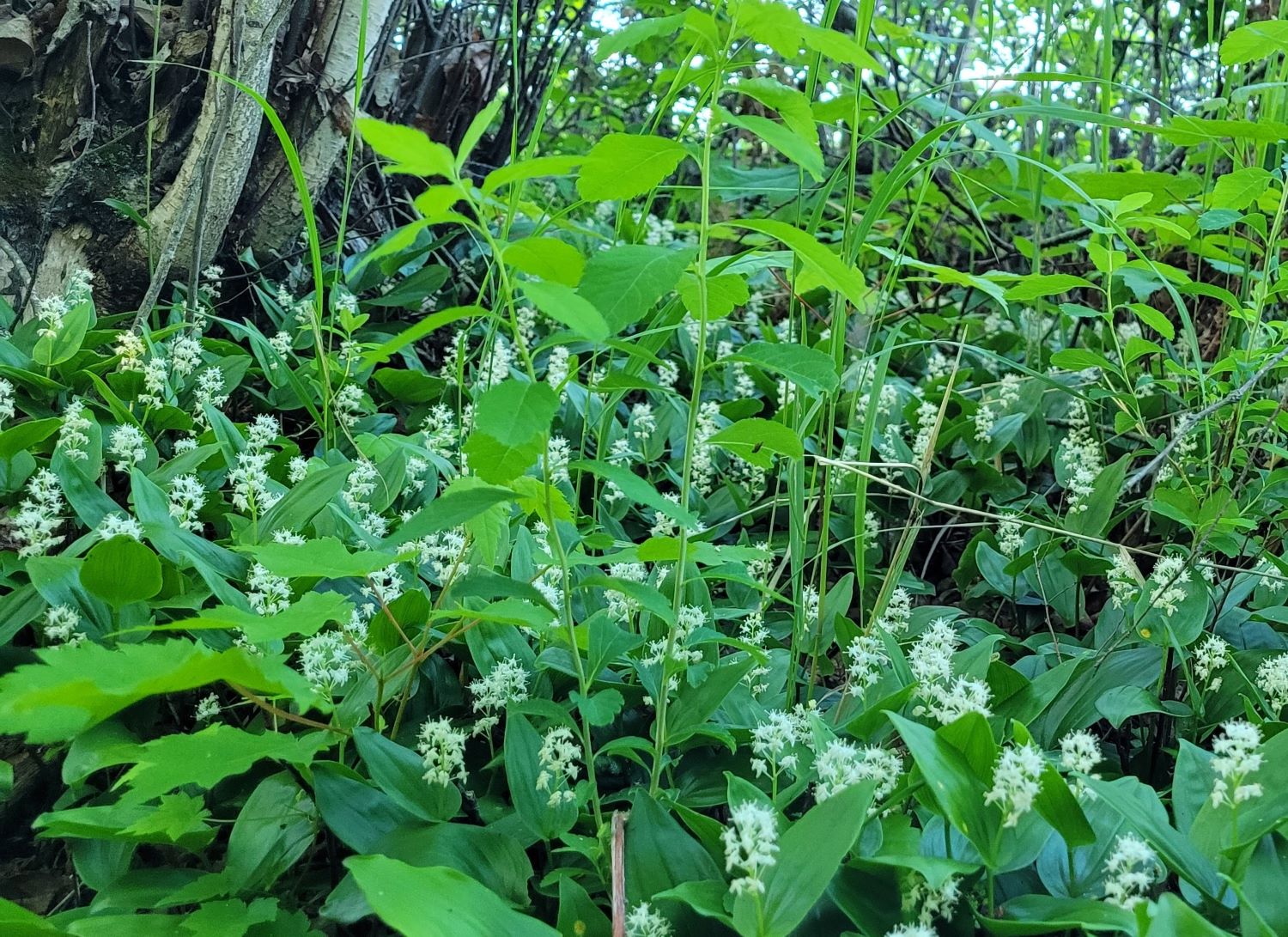
If you already have a forest in your backyard, resist the temptation to clean out the undergrowth. Species that may appear small and less interesting are probably shrubs or flowering plants. Their fruits are surely an essential food source for all kinds of birds, mammals and beneficial insects! And that’s not counting the essential contribution of ferns and mosses to the creation of a healthy forest.

Photo: Marian Whitcomb
Tips for forest gardens
- The idea behind creating a forest garden is to restore the habitat that was once present in much of our land before European settlement.
- We can’t always know what specific species were present before the landscape was transformed, but we can work towards it by planting species native to New Brunswick’s forests and shady areas.
- It may seem difficult to start with a lawn and create a forest garden. Start by planting native trees, such as sugar maple and red oak, and you’ll be rewarded in later years with shade to encourage ground cover species and shrubs adapted to the forest.
C) Rain gardens and ponds
For wet, poorly drained land, ditches and areas near gutters and asphalt

Rain gardens are created in low-lying areas to reduce runoff and lessen the impact of climate change, while attracting pollinators and other beneficial animals!

Ideally, plants with long roots should be used, so that they can filter and absorb rainwater. This will reduce pollution and the impact of flooding.

A pond can attract a large number of animals such as amphibians (frogs, salamanders) and various species of birds to your yard. Avoid planting or adding invasive species, whether fish or plants, to prevent them from spreading into the environment.
Tips for rain gardens
- A low-lying area in your yard is the ideal place to install deep-rooted plants that tolerate waterlogged soil during heavy rains.
- Plants that tolerate occasional flooding include Blue Flag Iris (Iris versicolor), Joe-Pye Weed (Eutrochium maculatum) and even Cardinal Flower (Lobelia cardinalis).
.
Tips for creating a naturalized artificial pond
- It’s possible to transform a poorly-drained corner of your yard into a thriving aquatic ecosystem.
- If the pond is filled with native plants, these will filter the water to remove nutrients that could promote algae growth.
- The frogs and dragonflies that eventually visit the pond will eat the mosquitoes, preventing unwanted invasions.
- If mosquitoes are a problem, consider adding an air pump to oxygenate the water.
- The same plants as for the rain garden can be used for the sides of your pond. Some species can even grow directly in the water, such as: Sweetflag (Acorus americanus); Pickerelweed (Pontederia cordata)
D) The meadow (field)
Good for sunny, low-traffic lots

- The field or meadow acts as an excellent transition zone between the forest and the lawn.
- If you already have a field near you, cut it less often (for example, once a year or less) to preserve the species found there.
The meadow or field is a sunny space made up of a wide variety of grasses and flowering plants. There are several layers, or strata. These layers vary from season to season, but it’s generally accepted that there are three main levels:
- Groundcover plants: These plants, which don’t grow very high (pussytoes, sedges, sweetgrass, native violets), help create a shield against invasive species.
- The seasonal layer: Flowering plants that have a specific interest over a short period (some shorter goldenrods, Asters, Red Columbine).
- The structural layer: Anything that grows taller, such as plants over one metre (three feet): (Fireweed) Chamaenerion angustifolium; native grasses; tall goldenrods (Solidago sp.), but also field shrubs (Serviceberry/Amelanchier, Sumac, Hawthorn) that add structure to the meadow.
(Source: Planting in a Post Wild World, C. West and T. Rainer, p. 173)
If you have a large yard, it’s excellent to keep an area of meadow for wildlife. For areas close to houses or streets, you need to demonstrate your intention to have a well-maintained yard by complying with municipal by-laws on long grass where they apply (Shediac).
The importance of preserving our fields
If you have a large expanse of lawn, it’s hard to go back to a wildflower field, since lawns aren’t designed to grow without mowing all year round. Above all, it’s easier to promote the existence of wildflower fields, which are becoming increasingly rare. In this way, we can help make native plants more visible in our communities! However, it is possible to imitate the wildflower field effect by creating flowerbeds that respect the meadow principle.
E) Other ways to help nature in your backyard
Here are a few other ideas to help promote local biodiversity.
- Incorporate an organic vegetable garden into your yard, so you can feed yourself locally without pesticides.
- See the page on Organic Gardening and the video series “A healthy garden”.
- Create a natural buffer zone around watercourses, to help improve water quality and reduce erosion.
- See the page on riparian buffer zones
- Create a shrub hedge that will give you privacy, as well as attract beneficial insects and birds!
- The “Small shrubs” and “Medium shrubs” sections below will give you some ideas.
- No room to spare? No problem! Your balcony will do just fine, thanks to pots in which native plants can grow.

Photo: Neil Vinson
Where to start?
Begin one native plant at a time. Build up your knowledge over the years, and get involved in local initiatives to improve the supply and availability of native plants. You’ll surely see the impact of your good decisions in the number of insects, birds and other animals that visit your yard! Try the plants listed below and consult the links at the bottom of the page to find out more.
Native plant suggestions
There are many resources available for choosing plants. That means there are many ways to find out which native plants to include in your yard.
We’ve chosen four:
- The VASCAN site determines whether the plant is native to our province and gives the names in English and French.
- GoBotany and the Native Plant Trust Plant Finder are American resources that have a place here, since we share many plant species with New England. These sites provide information on growing conditions and identification of plants found in the region. A map shows the distribution of each species and whether it is native or introduced.
- Wild Plants From Seed provides information on flower and seed maturity dates, and techniques for germinating them.
If you want to choose your own species, use these resources. Find out where the native plants you incorporate into your yard come from. Make sure they’re as native as possible to avoid introducing invasive species. Also, get plants grown from seed if possible.
Large trees
Native trees offer many benefits to animals and provide useful shade during the heat of summer, while reducing the heat island effect. In rural areas, trees like sugar maple are an excellent substitute for Norway maple (Acer platanoides), an invasive species spreading through the region’s forests. Visit EcoVision’s Native Trees page for more information on the benefits of Acadian-Wabanaki Forest trees.

Sugar Maple (Érable à sucre)
This maple is known as the main tree used in maple syrup production. Our native maples are known for their orange and red hues in autumn. This is an excellent tree for creating year-round interest.
Source : USDA Plants Database (PDF)
Informations

Red Oak (Chêne rouge)
Quercus rubra
Oaks are the most productive trees in terms of beneficial insects (source). Planting our native oak will not only help encourage beneficial insects, but will also provide shade for your forest garden or home.
Source : USDA Plants Database (PDF)
Informations

Eastern White Pine (Pin blanc)
The Eastern White Pine is the largest tree in the Northeast of our continent. Its four-season interest and large needles make it a bold choice for your yard. Many species of insects visit it, and many birds eat its seeds.
Informations

White Cedar / Arborvitae (Thuya / Cèdre blanc)
Thuja occidentalis
Thuja occidentalis, also known as white cedar, is equally interesting in all four seasons. Native to here, it provides habitat for birds even in winter.
Informations
Large shrubs and medium-sized trees
These shrubs and trees offer similar benefits due to their size and importance to wildlife. Some of the following species are interesting for their berries of different colors and shapes, which birds feed on. Their flowers provide an early source of pollen for pollinators.

Allegheny serviceberry, smooth shadbush (Amélanchier glabre)
Amelanchier laevis
Large shrub with beautiful reddish leaves and white flowers in spring. Produces many berries, ranging from pink to violet, which feed the birds.
Informations

Black Cherry (Cerisier tardif)
Prunus serotina
A member of the wild cherry family. Its dark-red berries attract birds, and its spring flowers are highly productive in terms of pollen for insects.
Informations

Rowan / American Mountain-Ash (Sorbier d'Amérique / Cormier)
Sorbus americana
Composite leaves with 11 to 17 leaflets (parts) give this shrub its proud appearance. Its fruits, ranging from orange in autumn to bright red with the arrival of the cold, are persistent in winter and attract birds.
Informations

Ironwood / Hop Hornbeam (Ostryer de Virginie)
Ostrya virginiana
Shrub usually growing under the forest canopy, with semi-evergreen leaves in winter. Produces hop-like “fruits”. Feeds many species of moths(2).
Informations
Medium shrubs
The medium shrubs we propose are once again very prolific in feeding wildlife. They are ideal for creating structure in the middle of a flowerbed, without dominating the yard too much. They can also be integrated into a variety of hedges along property boundaries. You can also create a hedge of native shrubs to feed the birds. It will provide shade, wind protection, privacy and a spectacle of pollinators and birds.

Witch-Hazel (Hamamélis de Virginie)
Hamamelis virginiana
One of the few shrubs to bloom late into autumn. Its yellow flowers and large leaves are of great interest. In winter, its petals drop, and the hard fruit appears in spring, maturing late in summer before bursting open to release the seeds.
Informations

Common Elderberry (Sureau du Canada)
Sambucus nigra ssp. canadensis
The beautiful flowers feed pollinators and the fruit is delicious for birds. Turning black when ripe, these berries have been used by native peoples for millennia for all kinds of purposes.
Informations

Highbush Cranberry (Viorne trilobée)
Viburnum opulus var. americanum
This viburnum belongs to a family of shrubs common to the Northern Hemisphere. The larger, sterile flowers of this viburnum form a ring around the fertile flowers, which are pollinated by both wind and insect pollinators. In late summer, the bright-red fruit attracts birds, which love it.
Informations

Winterberry Holly (Houx verticillé)
Ilex verticillata
Its berries are excellent for feeding birds, as they persist well into winter. The bright red berries are accompanied by green leaves in autumn. This medium-sized shrub performs best in wetter areas.
Informations
Small shrubs
Small shrubs can often be integrated into a flower bed, creating interest in all seasons.

Bayberry (Myrique de Pennsylvanie)
A salt-tolerant shrub that thrives by the sea. Interesting for its glossy leaves. Female plants produce white-blue fruit.
Informations

Virginia Rose (Rosier de Virginie) or Carolina Rose (Rosier de Caroline)

Lowbush Blueberry (Bleuet sauvage)
Vaccinium angustifolium
The blueberry is a countryside classic! Early blooming, it attracts many types of native bees and gives delicious fruit in late summer.
Informations

Red-osier Dogwood (Cornouiller hart rouge / stolonifère)
A shrub with four-season appeal. In summer, its beautiful green leaves are accompanied by white berries, and in winter, its young stems are bright red. Tolerates intensive pruning.
Informations
Groundcover plants
Groundcovers are flowering plants or very small shrubs that form mats on the ground, reducing the need to pull up unwanted plants. They are accustomed to growing through the mats of fallen leaves from local trees.

Wintergreen (Thé des bois / Gaulthérie couchée)
Its red berry is the source of the mint-like candy called Peppermint. Wintergreen is also a superb ground cover, with its greenery sometimes turning dark red. The thick, shiny leaves sometimes emerge from the snow in winter, hence the name.
Informations

Woolly Blue Violet (Violette parente)
This plant, a close relative of New Brunswick’s emblematic flower (the marsh blue violet), grows naturally in many lawns. It stays fairly close to the ground and is the host plant of Fritillary (Boloria) butterflies, which lay their eggs on the leaves.
Informations
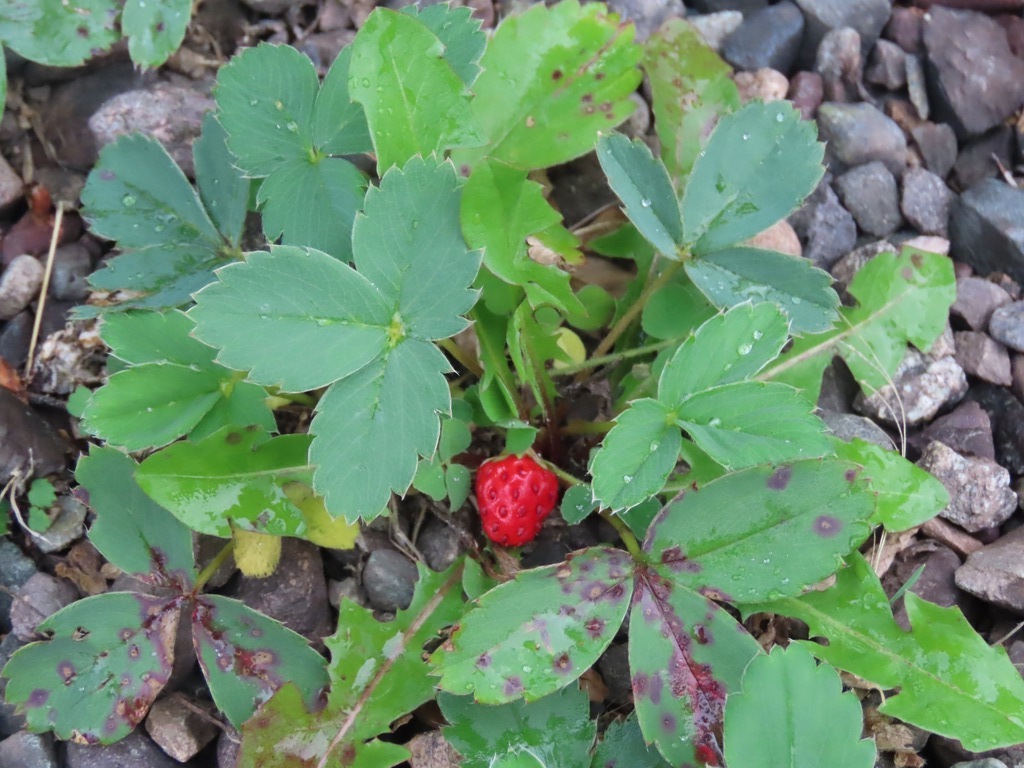
Wild strawberry (Fraisier des champs)
A small strawberry that grows naturally in lawns, with flowers appearing in May. Easily transplanted from lawn to flowerbed. Reproduces by runners, rhizomes (roots) and seeds, located on the surface of the fruit.
Informations
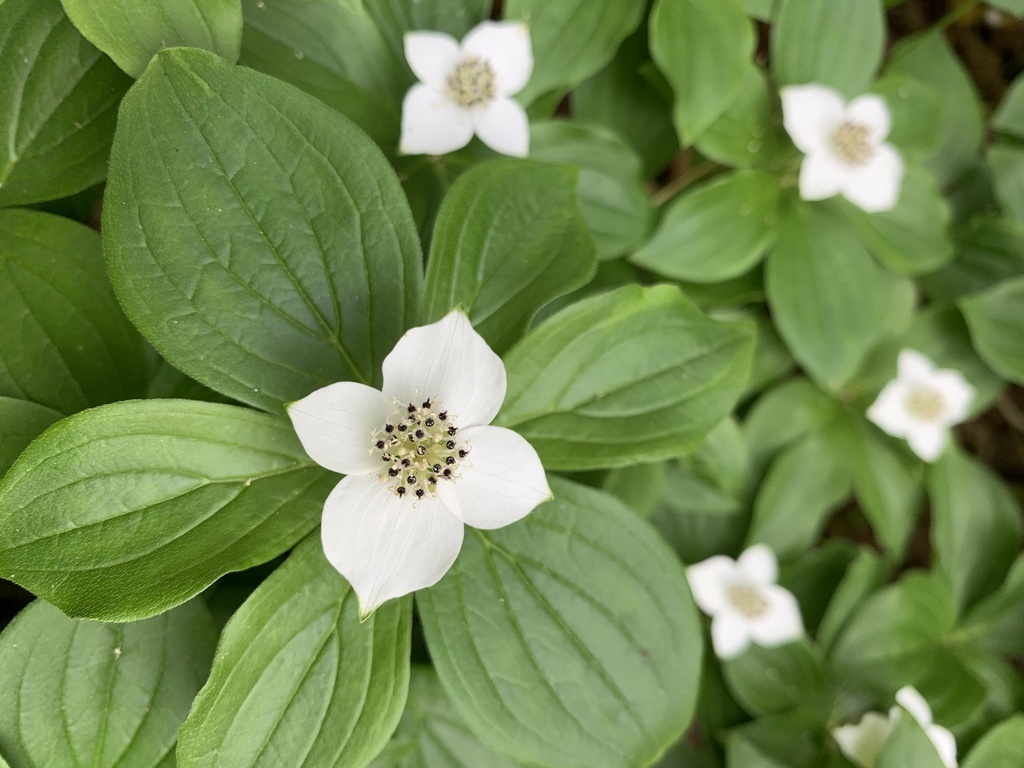
Bunchberry / Canada dwarf-dogwood (Quatre-temps / Cornouiller du Canada)
Cornus canadensis / Chamaepericlymenum canadense
A carpet of greenery that is very common in the forests of eastern North America. Flowers with four bracts (false petals) bloom in late spring, before producing red berries in mid-to-late summer. It thrives in dry, acidic soils, in woodlands and forests.
Informations
Flowering plants commonly sold in nurseries
Ask about these plants, which often appear in nursery catalogues in eastern Canada. These flowering plants are best suited to humid environments. Also ask about plants grown without pesticides, which can be harmful to insects and birds.

Swamp milkweed (Asclépiade incarnate)
Part of the only plant genus that feeds monarch butterflies. These beautiful pink flowers with slender leaves produce fluffy seed capsules in autumn.
Informations

Blue Flag Iris (Iris versicolore / Clajeux)
This beautiful purple-blue flower is adapted to damp areas and its leaves resemble long grasses. Does not tolerate dry areas.
Informations

Spotted Joe-Pye Weed (Eupatoire maculée)
This tall, wetland native makes an excellent focal point in a rain garden. It blooms from mid to late summer and produces large, spiky pink flowers.
Informations

White turtlehead (Galane glabre / Tête-de-tortue)
Bumblebees are often found head-first in turtlehead blooms, with their legs sticking out of the flower. This plant also feeds hummingbirds and other insects that manage to access the nectar down below.
Informations
Early-blooming plants (spring-summer flowers)
For season-long interest, opt for colourful native flowers that will enhance the colour palette of your flowerbeds, creating a buffet and habitat for pollinators! Late spring and early summer is a crucial time for beneficial insects seeking to breed on very specific host plants, or looking for pollen and nectar.

Wild Red Columbine (Ancolie du Canada)
Aquilegia canadensis
A magnificent flower that feeds hummingbirds as soon as they arrive. Tolerates sun and fairly dry soil.
Informations

Marsh Marigold (Populage des marais)
Caltha palustris
Water-loving plant. One of the few yellow flowers to emerge in early spring.
Informations

Golden Alexander (Zizia doré)
Zizia aurea
An excellent plant in the carrot and parsley family, useful for bees and other late-spring insects. Host to the Black swallowtail butterfly. Fairly versatile in terms of sun and humidity, but prefers the sun.
Informations

Blue Vervain (Verveine bleue)
This plant with its purple flowers is excellent for damp spots in the garden. The unique appearance of its flowers provides a nice contrast for the rain garden or pollinator garden.
Informations
Late-blooming plants (summer-autumn flowers)
Native plants from the same family as sunflowers (the Asteraceae) are the most abundant plants to flower in late summer, from August to early October. These late-bloomers are an essential source of pollen and nectar for pollinators, including bumblebees and monarch butterflies, as they prepare for winter by hibernating or migrating south.

Common Boneset (Eupatoire perfoliée)
Eupatorium perfoliatum
A plant with white compound flowers, it is shorter than its cousin, the Joe-Pye Weed. The leaf seems to encircle the stem, hence the name perfoliate. Forms small colonies.
Source: USDA Plants Database (PDF)
Informations

Heart Leaved American-aster / Blue Wood aster (Aster cordifolié)
Symphyotrichum cordifolium
Aster with lavender flowers. This species grows naturally in our fields, and attracts many pollinators in autumn.
Informations

Seaside Goldenrod (Verge d'or toujours verte)
A plant that grows naturally along salt marshes, coastlines and roadsides. Very salt-tolerant and less aggressive than other goldenrods. Blooms in autumn, like other members of its family.
Source: USDA Plants Database (PDF)
Informations

Flat-top Aster (Aster à ombelles)
Doellingeria umbellata
This plant brings shades of white to our autumn meadows. Its ornamental potential lies in its large size and dramatic appearance.
Informations
Ferns and Grasses
Ferns are a common sight in the undergrowth, but they also have their place in our gardens! Their green fronds and spiral shoots in spring make them an excellent attraction in shady areas. And let’s not forget grasses, sedges and rushes, a group of plants at the base of many wetland and dryland ecosystems, which provide food for birds and mammals.

Ostrich fern (Fougère à l'autruche)
Matteuccia struthiopteris
Its spring shoots, a sign of the onset of warmer weather, are known as “fiddleheads”. Its fronds make an excellent addition to any shade garden, giving them a unique structure.
Informations

Rattlesnake manna grass (Glycérie du Canada)
Glyceria canadensis
Beautiful grass with wheat-like, but drooping, spikelets. Found in wetlands, including marshes and riverbanks.
Informations

Canada Wild Rye (Élyme du Canada)
Elymus canadensis
Grass with superb spikes that provides excellent cover for birds and insects.
Informations

Fringed sedge (Carex crépu)
Carex crinita
Plant of the sedge family, triangular grasses with interesting structures, beneficial to wildlife. This one in particular has hanging perigynia (spikes), making it very attractive.
Informations
I am a native grass, not a lawn!
The group of non-native grasses that make up a lawn can be trampled without any problem. Unlike these, most of our native grasses, which feed and provide habitat for wildlife, do not tolerate trampling. Don’t mow these native plants, but rather let their beautiful spikelets appear! They’re best suited to planting in clumps, and left to grow long in our flowerbeds.
Interesting links
Visit these websites to learn more about three essential aspects of creating a more natural yard.
Choosing the right species
GoBotany is a New England site across the border that includes northern Maine in its area covered. It’s an excellent resource for identifying species keys and ranges (NB is included on the edge of their maps).
The Native Plant Trust, which operates GoBotany, also has a tool for selecting native plants for specific site conditions. By selecting the type of soil and sunlight in your yard, you’ll get a list of suitable plants. It’s a great place to start.
VASCAN is a site for determining whether a plant is native or not. It’s also a very useful tool for finding out all the scientific and common names of species in English and French.
If you enjoy reading about native plants and the beneficial insects that feed wildlife, some recommended authors are Douglas W. Tallamy (Bringing Nature Home, Nature’s Best Hope), Heather Holm (Pollinators of Native Plants) and Lorraine Johnson (A Northern Gardener’s Guide to Native Plants and Pollinators). These three authors take a scientific yet practical approach to determining which species to plant for a garden that respects the needs of beneficial insects.
Obtaining seeds and plants
Here are a few suppliers of native plant seeds. Note that these highly specialized for-profit companies don’t yet exist here, so be sure to choose the right species.
Seed libraries are volunteer initiatives that don’t operate year-round. Selection can also be limited, so be quick when the opportunity arises!
Nature NB has a program that donates milkweed seeds.
How to grow plants
Winter sowing is the easiest way to grow native plants from seed. Follow these instructions to break the dormancy process and get lots of seedlings.
Enjoying nature
Community Science
Participate in science by recording what’s in your landscaped space!
Identification
Applications exist to help you discover the species that frequent your naturalized space.
Sources
1 – Douglas W. Tallamy (2019) Bringing Nature Home
2 – Gaden S. Robinson; Phillip R. Ackery; Ian Kitching; George W Beccaloni; Luis M. Hernández (2023). HOSTS – a Database of the World’s Lepidopteran Hostplants [Data set]. Natural History Museum. https://doi.org/10.5519/havt50xw
3 – C. West et T. Rainer (2015) Planting in a Post Wild World, p. 173

This initiative is sponsored by:





